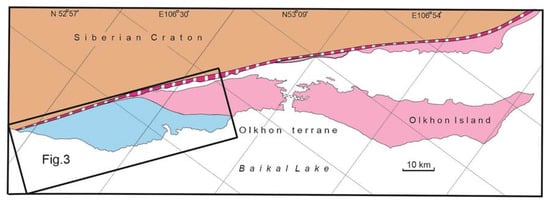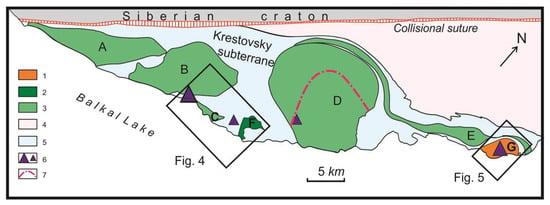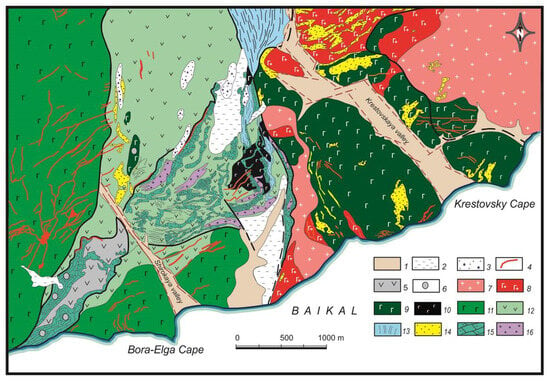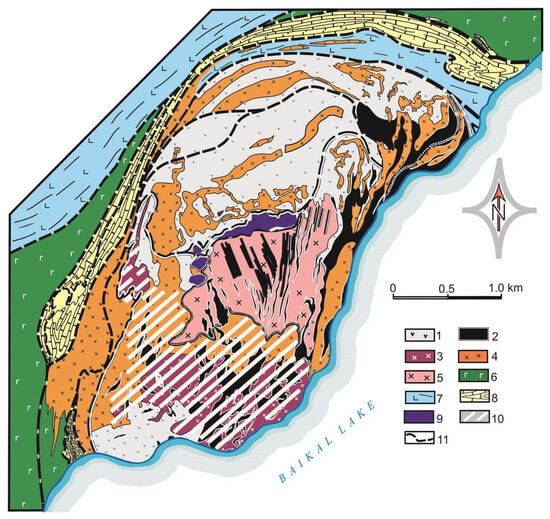Some metamorphic rocks discovered within the Olkhon terrane on the western side of central Lake Baikal (southeastern Siberia, Russia) are remarkable for their hornfels-like features, granular textures, and mafic compositions, with a typical mineral assemblage of Opx+Cpx+Amp+Pl+Ilm±Ol±Bt±Spl±Ti-Mag (here and below mineral abbreviations are after [
1]). For several reasons discussed in detail below, the rocks cannot be identified as hornfels, which commonly form under the thermal effect of hot intrusive material on igneous or sedimentary protoliths. On the other hand, the Olkhon hornfels-like granular rocks are perfectly identical in their mineralogy, structure, and texture to the metamorphic rocks described earlier as beerbachite.
The term beerbachite was coined by C. Chelius [
2] in the late 19th century and applied to fine granular two-pyroxene-plagioclase-magnetite (ilmenite) dike rocks with a saccaroid texture found in the Odenwalde gabbro intrusion in Germany. That description by Chelius was included in the book of Rosenbusch [
3], a classical treatise that was a bible for many geologists in the first half of the 20th century. The Odenwalde beerbachite [
2] was later reinterpreted by Klemm [
4] as metamorphic sedimentary inclusions of a mafic composition rather than dikes and by MacGregor [
5] as hornfels derived from mafic igneous protoliths. Nevertheless, the interpretation of beerbachite as dike rocks in coarser gabbro remained a predominant view, supported by Bloxam [
6], MacGregor [
5], Phillips [
7], Dixey [
8,
9], Wells [
10], etc. In his overview of published and original data, Phillips [
7] suggested distinguishing dike and xenolithic beerbachites and explained the metamorphic structures and textures of dike rocks by thermal alteration during intrusion into already crystallized yet still hot gabbro. In later publications (e.g., [
11]), beerbachites from different gabbro bodies worldwide were interpreted either as dikes or as metamorphosed country rock xenoliths. In addition to gabbro, beerbachite occurrences were reported from a sheeted dike–gabbro transition zone in an oceanic crust area [
12]. However, the publications where beerbachites would be at least mentioned, if not characterized, have been very limited, and the term itself was rejected as redundant. Beerbachite enclosed in gabbro would be identified well enough as a high-temperature mafic variety of hornfels (pyroxene hornfels facies of contact metamorphism).
2. Regional Geological Background
2.1. Olkhon Terrane
The Olkhon composite terrane includes Olkhon Island and the adjacent landmass of the western Lake Baikal shore. It belongs to the Early Paleozoic Baikal collisional belt, delineating the southern periphery of the Siberian craton together with the Sludyanka and Kitoikin terranes (
Figure 1). The Olkhon terrane is an intricate collage of 500 Ma and 460 Ma genetically different igneous and metamorphic complexes ([
13,
14] and references therein). The terrane is composed of two major units (
Figure 2): (i) Krestovsky subterrane composed of gabbro (over 50% of total rock volume) and metamorphic rocks (marble and amphibolite) and (ii) a package of tectonic units [
14] composed mainly by gneisses with lesser amounts of marble, amphibolite, and quartzite, as well as gabbro and granite intrusions and numerous granitic, pegmatitic, and aplitic veins. The formation of the terrane was interpreted [
13] as resulting from successive events of thrusting, doming, and strike–slip faulting, with syntectonic high-temperature metamorphism and intrusions of mafic and granitic magmas. The well-documented rocks produced by the three major tectonic events originated in the Early Paleozoic as a result of microcontinent–island arcs and microcontinent–continent collisions [
13]. It was the extensive strike–slip faulting that controlled the general tectonic framework of the terrane, consisting of multiple blocks and shear zones that differ in structure, morphology, and composition.
Figure 1. Simplified tectonics of Central Asia (
a) and metamorphic terranes in the Early Palaeozoic Baikal collisional belt of northern CAOB (
b), modified after [
14].
Figure 2. Simplified tectonics of the Olkhon terrane, modified after [
14].
The history of the Olkhon terrane included at least two events of metamorphism that occurred under different P-T conditions [
15]. Granulite facies metamorphism, around 500 Ma [
16], was restricted to a narrow zone along the collisional suture between the terrane and the Siberian craton. Other metamorphic rocks of the terrane, from granulite to low amphibole facies (gneiss, amphibolite, marble, etc.), resulted from the collisional activity of 460–470 Ma [
16,
17].
2.2. Krestovsky Subterrane
The largest part of the Krestovsky subterrane is occupied by the gabbro of the Birkhin (500 Ma) and Ust’-Krestovsky (460–470 Ma) complexes [
18] (
Figure 3). The Birkhin volcanoplutonic complex [
18,
19] consists of gabbro and porphyritic volcanics, often metamorphosed to amphibolite facies, as well as conduit dikes, especially numerous among calcitic marbles in the Baikal coastal cliffs. The origin of the Birkhin complex was previously explained as the magmatism of two phases [
20] that produced the Krestovsky, Bora-Elga (phase 1), Buguldeika, Ulan-Nuur (phase 2), and Birkhin (phases 1 and 2) intrusions. The rocks of both phases, including differentiated gabbro and pyroxenite of phase 1 and monzogabbro of phase 2, bear prominent suprasubduction signatures [
18]. Most recent data, however, indicate that the rocks from the two phases represent differentiated ankaramite magma instead [
21].
Figure 3. Simplified local geology of the Krestovsky subterrane of the Olkhon terrane: 1 = Tazheran syenite and gabbro, 470–460 Ma (G); 2 = Ust’-Krestovsky intrusion of subalkaline gabbro, 470 Ma (F); 3 = Birkhin gabbro (500 Ma), including Buguldeika (A), Krestovsky (B), Bora-Elga (C), Birkhin (D), and Ulan-Nuur (E) intrusions; 4 = an intricate package of thrust sheets composed mostly of granite and gneiss; 5 = amphibolite and marble of the Krestovsky subterrane; 6 = beerbachite occurrences: fields (large triangles) and altered dikes among gabbro and marble melange (small triangles); 7 = shear zone marked by beerbachite dikes, granite, and marble veins.
The Ust’-Krestovsky complex of gabbro is composed of high-Ti and high-alkaline Ti-fassaite monzogabbro, pyroxenite, and nepheline-Ti augite rocks (phase 1) and phlogopite monzogabbro (phase 2), often altered to amphibolite and gneiss, with moderate Ti contents. The rocks of phase 1 form several small bodies along the sides of the Krestovsky Valley (
Figure 4) and are related to high-temperature pyroxene hornfels after the Birkhin porphyrite. Phase 2 rocks occur as part of the Ust’-Krestovsky intrusion within the Krestovsky Valley (
Figure 4) and local dikes in marble. They are compositionally similar to subalkaline metagabbro in the Tazheran Massif and composite mafic dikes in northern Olkhon areas [
18]. The Ust’-Krestovsky gabbro samples likewise bear suprasubduction signatures but differ from the Birkhin volcanoplutonic rocks in higher contents of Ti and incompatible elements [
18].
Figure 4. Geological map of the southwestern Krestovsky subterrane: 1 = quaternary alluvium; 2 = quaternary lacustrine–marsh deposits; 3 = quaternary geyserite; 4 = granite veins; 5 = beerbachite, 470 Ma; 6 = small blocks of beerbachite; 7 = Khaidai complex of granite and granodiorite; 8–10 = Ust’-Krestovsky complex of gabbro and granite (485–470 Ma): mingling gabbro, leucogabbro, and syenite (8), monzogabbro, leucomonzogabbro, and quartz-bearing syenite in phase 2 (9), and hybride gabbro in phase 1 (10); 11 = Birkhin gabbro (500 Ma): olivine gabbro, monzogabbro, and monzogabbronorite; 12 = Tsagan–Zaba complex of metaporphyrite and amphibolite after porphyrite (500 Ma); 13 = diopside–quartz–calcite rocks; 14 = injection marble; 15 = marble melange; 16 = quartzite.
The Tazheran Massif in the northeastern part of the subterrane is an intricate complex of igneous, metamorphic, and metasomatic rocks (
Figure 5) separated from the marble country rocks by a blastomylonite zone of ductile deformation. The igneous rocks are mainly 470 Ma gabbro–dolerite [
22] as well as syenite, mostly gneissic, less abundant subalkaline gabbro, commonly gneissic, limited amounts of nepheline syenite, and a few veins of granite and pegmatite. The age of the subalkaline gabbro remains unconstrained within the complex but can be inferred from the age of the compositionally identical Ust’-Krestovsky gabbro dated in other occurrences at 470–460 Ma [
18]. Nepheline syenite occurs commonly as linear or intricately shaped veins, from 20 cm to a few meters thick, less often a few tens of meters, with age constraints between 467 Ma and 454 Ma determined by different methods [
22]. The granite and pegmatite veins, the youngest igneous bodies in the complex, are limited to a few sites and vary in thickness from 1 m to 10 m. The Tazheran metamorphic rocks are mainly brucite or dolomite-bearing calcite marbles, which were previously interpreted as xenoliths in igneous rocks. On the other hand, they differ from mantle carbonatite in mineralogy and chemistry. Alternatively, a wealth of geological evidence rather suggests an origin by injection nearly synchronously with subalkaline gabbro and nepheline syenite [
22]. They may represent melt batches produced by melting sedimentary carbonates in the lower crust and then ascending to emplace at shallower depths [
22]. Diverse, mainly high-temperature metasomatic rocks are found among the Tazheran carbonates.
Figure 5. Simplified geology of the Tazheran Massif, modified after [
19]: 1–5 = Tazheran complex, 460–470 Ma: beerbachite after tholeiitic dolerite and gabbro (1), subalkaline gabbro and microgabbro (2), nepheline syenite (3), foliated (4), and massive (5) syenites; 6–8 = country rocks: metamorphosed gabbro, monzogabbro, monzonite, and syenite of the Birkhin complex, 500 Ma (6), silicate–carbonate gneiss (7), and calcitic marble (8); 9–10 = fields of occurrences of alkaline (9) and magnesian (10) metasomatic rocks; 11 = synmetamorphic ductile detachment.
Carbonate rocks occupy a large part of the Krestovsky subterrane and are either calcitic or dolomitic varieties. The predominant calcitic marble occurs as elongated bodies in a large field in the central part of the subterrane. Dolomitic and dolomite–calcitic marbles associated with silicic rocks (quartzite, diopside–dolomite–calcite, tremolite–calcite, and quartz–diopside varieties) form an S-shaped band in the southwestern part of the terrane and grade westward into exposures of marble melange. Marble melange is also widespread in the south of the terrane, where it encloses blocks and fragments of silicate rocks ranging from a few mm to tens of meters in size.
The rocks of the Krestovsky subterrane are of low amphibolite metamorphic facies formed mainly at 500–600 °C [
15], except for rocks at two sites where the crystallization temperature of minerals reached 800–900 °C. One site is associated with the interaction of phase 1 Ust’-Krestovsky gabbro with the Birkhin metavolcanics (see above), while the origin of the other site in the west remains poorly understood. The idea that the thermal high at the second site would be likewise related to the Birkhin gabbro [
23] is inconsistent with the presence of wide amphibolite zones between the gabbro and the high-temperature metamorphic rocks.
Many metasomatic rocks in the Krestovsky subterrane occur along the contacts between different lithologies (e.g., amphibolite and marble) or within shear zones of the Birkhin complex rather than in association with granites or other intrusive rocks. Metasomatism mostly developed at moderate temperatures (garnet–epidote–amphibole–pyroxene, zoisite–amphibole–pyroxene, and other compositions), though high-temperature varieties with melilite, kilchoanite, tilleyite, and other minerals are present as well [
24,
25]. Judging by their occurrence, the origin of moderate-temperature metasomatic rocks was due to tectonic deformation and syntectonic metamorphism.





